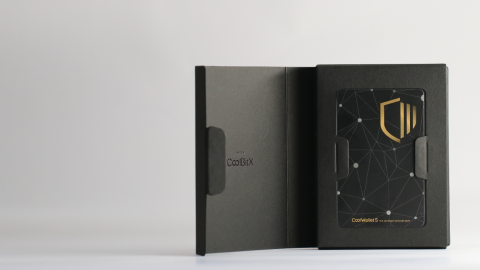Crypto has once again experienced a major crisis, on a scale that dwarfs even the biggest scandals in existence, the Mt. Gox hack in 2014 and the Luna Terra collapse earlier in 2022. The spectacular implosion and subsequent “hack” of leading crypto exchange FTX, thought by many to be the most well-regulated exchange in the world, can arguably be considered to be the crypto industry’s darkest day to date and reaffirmed the case for responsible self-custody of one’s crypto holdings.
FTX, which was until very recently the world’s third-largest centralized exchange and valued at $32B, has filed for bankruptcy. The size of the hole in its balance sheet is unknown but is likely larger than $8B.

We’re only in the first stages of the devastation, and it’s likely to get more severe. The ripple effect is going to take some time to play out. It’s safe to say that after the smoke clears, we are going to be in a different crypto landscape and that one day, we might even see a movie or two about the events that played out over the last week.
Already, the reputation of the industry has endured damage that may take years to repair. And FTX founder Sam Bankman-Fried (SBF), whose fortune plummeted from over $24B to under $1B overnight, is now even more notorious than disgraced LUNA founder Do Kwon, and likely on the run.
What do we know so far about the collapse of FTX? Quite a lot, though new details continue to pour in. The story is as fast-moving as crypto has seen, with events playing out in real time over Twitter timelines as shocked pundits, investors and industry leaders dissected the damage and kept users informed of what had happened and was unfolding. On Twitter Spaces, even Elon Musk joined in as Twitter users discussed what was next.
If ever there was a case for keeping your crypto on a hardware wallet like CoolWallet, where you control the keys to your crypto investments, then the demise of FTX and SBF is it.
Let’s take a look at what we can piece together about the chain of events and the takeaways for the community. Here’s how it played out. Ignore the unofficial “The Office” version below that did the rounds on social media
FTX implosion: Timeline
November 2
CoinDesk releases a report about the balance sheet of FTX’s sister firm Alameda Research. According to the outlet’s sources, $5.8B out of the $14.6B on the balance sheet is tied to the exchange’s native token, FTT, while the bulk of the rest is tied up in largely illiquid coins. This is a disturbing revelation that sets off the chain of events that ultimately bring FTX to a fall.
November 5
A popular Twitter account that tracks large movements of cryptocurrencies reports that 23M FTT (then worth $584.5M) has been moved onto Binance. The funds are equal to 17% of the then-total supply of FTT.
November 6
Caroline Ellison, the CEO of Alameda, tweets that the balance sheet reported on by CoinDesk was only a partial representation of the firm’s finances. An additional $10B in assets, she claims, were unmentioned in the leaked document.
Later in the day, the founder of rival exchange Binance, Changpeng Zhao (CZ), announces that his company will be liquidating its FTT holdings due to the FTX revelations. He adds that he won’t support people who lobby against other industry players, which is a reference to SBF’s Washington push for decentralized finance (DeFi) regulation. CZ says the liquidations will occur over several months to limit damage to the markets.
The Binance CEO’s move is met by an offer from Ellison to buy all of Binance’s FTT shares at $22. Oops.
In hindsight, many consider Ellison’s offer to be the straw that broke the camel’s back, revealing, just as with Do Kwon’s tweets while Terra USD began to depeg, the exact price that was being defended and if breached, could trigger a collapse. This unleashed an avalanche of shorts against the beleaguered cryptocurrency, forcing its issuer FTX to drain its funds trying to prop up its value. They eventually fail dismally, just as Luna did.
November 7
Reports begin to emerge of people having a hard time withdrawing funds from FTX. The exchange assures the public that everything is fine.
SBF gets involved, tweeting that a competitor is spreading rumors about his exchange. He assures that FTX does not “invest client assets” and that the exchange’s assets exceed its liabilities by $1B. He calls on his rival to work with him for the good of the industry.
CZ shoots down Ellison’s offer of $22 per share. “I think we will stay in the free market,” he tweets.
November 8
As alarms begin to reach a fever pitch, the price of FTT falls 30% in several hours from $22 to $15.40. Other cryptocurrencies begin to show signs of the impact as well.
SBF shocks the industry by announcing that Binance will soon purchase FTX, though the agreement is non-binding. He says that assets will be covered 1:1 and that the move is the solution to a “liquidity crunch.” He deletes his earlier tweets in which he confronted CZ.
November 9
Binance backs out of the deal to acquire FTX, citing reports of “mishandled user funds” and investigations. The company adds that the situation is beyond its power to assist.
Crypto markets continue to slide, with Bitcoin hitting a low of $15,600.
SBF seeks to raise up to $8B to plug the gaps in FTX. Meanwhile, the exchange stops processing withdrawals.
November 10
The venture capital firm Sequoia Capital reveals it has designated its $213M investment in FTX as worthless, though it otherwise claims limited exposure.
FTX US, which has so far remained operational, warns users it will halt trading but keep withdrawals open.
Regulators in the Bahamas, where FTX and Alameda are headquartered, freeze the assets of the exchange’s local entity.
SBF tells his Twitter followers he “should have done better.”
November 11
Alameda employees resign en masse.
FTX files for bankruptcy in the US, claiming between $10B and $50B in liabilities for FTX US and Alameda, respectively, while reporting assets in the same range.
SBF resigns and John Ray III is appointed CEO. Ray is an expert in winding down distressed entities. He previously oversaw the bankruptcy process for Enron.
Later that night, reports come in that FTX’s remaining funds in wallets are being drained. Up to $600 million in crypto is emptied out of FTX’s wallets and In short, all of it. Adding to the fear and panic, FTX users are warned not to open the app or visit the website as it’s likely been infected with a virus or other malware. The current missing funds tally stand at between 1 and 2 billion dollars.
The finger is soon pointed at a possible insider who gained access to the exchange’s wallets somehow: SBF himself, who allegedly months earlier forced employees to install a “backdoor” into the software in order to allow him to move customer funds to other accounts, such as Alameda Research. Whether or not that is true, is still under investigation at the time of writing.
Others point the blame at CZ from Binance who essentially set the bank run on FTX in motion with its initial tweet that rightfully cried wolf. This has led to this hilarious The Office video making the rounds on social media:
FTX implosion: Takeaways
Presently, the crypto industry is in a state of shock, as the FTX fiasco has unfolded in just a little over a week.
Until weeks ago, SBF had been regarded as not merely a wunderkind but also something of a saintly figure, living a semi-spartan existence despite his immense wealth. The former CEO is among the most visible proponents of the effective altruism movement, which teaches its followers to optimize their charitable giving based on a version of utilitarian philosophy.
SBF has also been seen as the “responsible” crypto CEO by many in Washington. This is a result of his lobbying efforts, which are unpopular in the industry. Whether the ongoing legislative efforts that he had consulted for will continue after his fall from grace remains to be seen.
Regardless of how the rest of this saga plays out, there are two main takeaways we can already see popping up everywhere.
Crypto needs more decentralization and transparency
The irony of a CEO of a centralized exchange that cooks the books lobbying for the heavy regulation of DeFi is too obvious to need unpacking. By all accounts, it seems SBF and a small crew of individuals in the Bahamas were taking extraordinary risks at FTX. Actions like the suspension of withdrawals have led analysts to question whether they weren’t in fact investing users’ deposits as well. And this information is only coming out now due to the lack of regulatory requirements surrounding disclosures for exchanges.
It’s no secret that DeFi is having a very rough time this year. Decentralized exchanges (DEXs) and especially cross-chain bridges continue to be hacked at an astonishing rate. Nevertheless, much of the DeFi ecosystem operates in a transparent manner, with projects built around open-source protocols. In time, the underlying code of these systems is likely to grow stronger. If centralized exchanges (CEXs) are going to be a part of crypto for the long haul, it’s essential regulation catches up and requires full transparency of them.
Self-custody is the only real way to keep your crypto safe
The Mt. Gox in 2014 gave birth to the CoolWallet hardware wallet. It was the biggest reason CoolBitX founder Michael Ou, with a family background in banking security started work on the first CoolWallet (launched in 2016 as the world’s first Bluetooth-powered Bitcoin mobile hardware wallet) that same year, trying to give the broad crypto community real peace of mind over their digital asset ownership.
In 2022, 8 years later, the question remains the same for everyone to ask themselves 2 questions:
- Why take the risk that comes with shady centralized crypto custodians all for that matter?
- Do you really own your crypto?
The answer to both questions are the same.
Get a hardware wallet.
Like, today.
Written by Werner Vermaak and Tim Rinaldi.
Not financial advice, and for educational purposes only.




